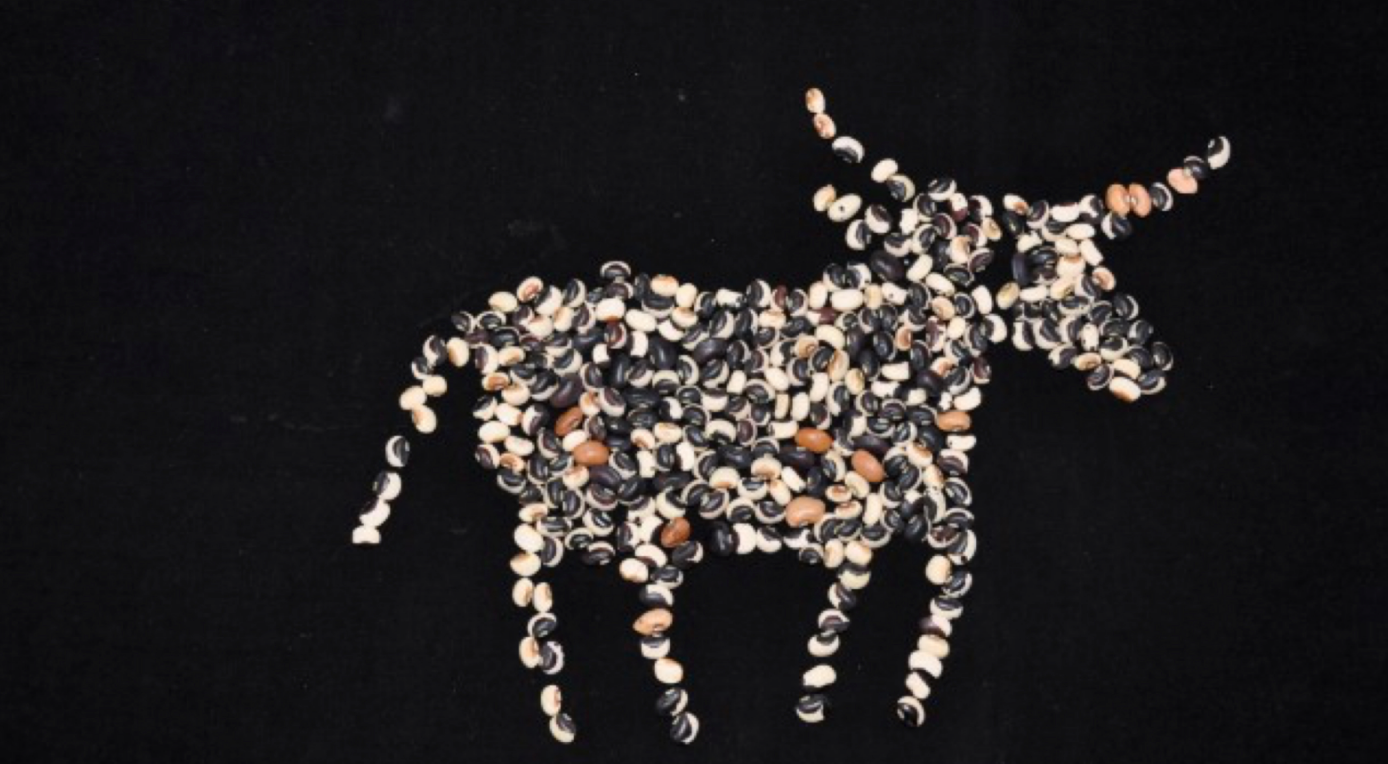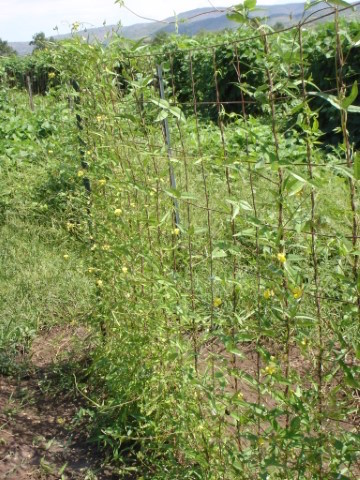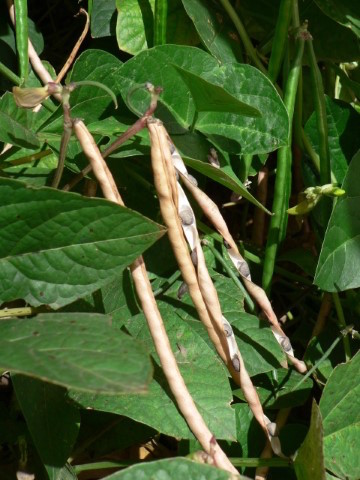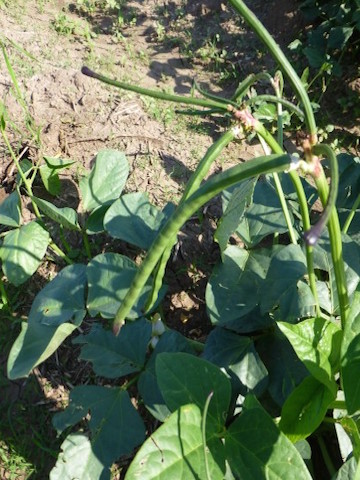
By Melissa Kruse-Peeples, Education Coordinator.
As spring turns into summer, gardeners are asking what crops can be planted that will actually survive the impending burning inferno that is Southern Arizona’s summer. At Native Seeds/SEARCH we encourage gardeners not to be afraid of the summer heat but to embrace the arid-adapted varieties of the Native Seeds/SEARCH collection. These varieties are arid-adapted, full-sun loving powerhouses. One of our favorite heat-loving varieties is Tohono O’odham cowpeas. In June and July when other crops seem to go dormant waiting for cooler temperatures, Tohono O’odham cowpeas grow so fast you can almost hear them. The lush growth will help shade the ground and create a cooler microclimate, AND they taste delicious! Immature pods are great raw in salads or sautéed with garlic and butter. As they ripen, the soft peas can be shelled and cooked or the dried pods can be harvested to accumulate for a big pot of cooked peas with a creamy texture and rich flavor.
Not actually a pea, the Tohono O’odham cowpea is a local variety of black-eyed pea from the Tohoho O’odham peoples of Southern Arizona and Northwest Mexico. Black-eyed peas are known for their popularity in Southern cuisine but their use is much broader.
The cowpea, Vigna unguiculata, was domesticated in Africa and is an introduced species in North America that thrives in the similarly hot climate. They were domesticated around 5,000-6,000 years ago, and are still important for food and fodder across Africa. They came to the Americas with the slave trade, and eventually moved across this continent with African slaves. They were often planted along the edges of fields to enrich the soil due to their high nitrogen fixing ability, and cattle would graze on the leaves and vines (hence the name cowpea). Many settlers of European descent were unfamiliar with the crop and regarded it merely as cattle fodder, not fit for human consumption; it was this misunderstanding of its culinary significance that might just have saved this food resource. During the Civil War, Union soldiers didn’t bother to torch the cowpeas when they burned Confederate fields as they marched through the south. This oversight may have saved both black and white families from starvation during this period, and it might be one reason for the association of cowpeas with good luck in the south.
Native Seeds/SEARCH conserves 31 accessions of cowpeas from Arizona, Texas, Sonora, Chihuahua, and Sinaloa. Within the collection there is a lot of diversity in dried pea color, growth habit (bush vs. pole), flower color, days to maturity, etc. All of the varieties in the collection can be considered landraces - locally adapted, traditional varieties that have developed over time through adaptation to their natural and cultural environment. The path of cowpeas from Africa to the Southwest isn’t well documented. Spain had black-eyed peas from Africa and likely introduced them to Mexico and the Southwest along with favas, garbanzos, wheat, fruit trees, and peas.
As for the Tohono O’odham Cowpea, it likely arrived to the Sonoran Desert area via Padre Kino in the 17th century. Cowpeas grow very similarly to traditional tepary beans which were already cultivated for 2,000 years by the time cowpeas arrived. Because they grow similarly to traditional beans and thrive in hot climates, cowpeas were easy to incorporate in traditional O’odham agriculture. The three Native Seeds/SEARCH collections of the Tohono O’odham cowpea came from farmers in Big Fields, Santa Rosa and Choulic village on the Tohono O’odham reservation. They are a beautiful white to cream bean with black mottling. In the O’odham language, cowpeas are called U’us mu:n or U’us Bavi. U’us, pronounced oo-oos, translates to stick, mu:n translates to bean and is similar to the word for beans in other Uto-Aztexcan languages (for example, muni is the Mayo word for bean). Tepary beans are called bavi, pronounced bahfv. Their name in O’odham describes exactly how they grow – a type of bean that looks like a stick. Pods of this cowpea grows long and straight. They form on the plant upright in the air and as the peas ripen the weight drops them down on the plant.
Growing
All cowpeas, including the Tohono O’odham variety can be planted throughout the warm season. Traditionally they are planted in the spring and the monsoon season. They thrive in the full sun. They should be planted 1” deep and 6” apart. They can tolerate poor soil conditions and can actually help improve soil fertility. Cowpeas, like all beans and peas, have the ability to fix nitrogen from the air and transfer it into the soil. Nitrogen fixation occurs as beneficial Rhizobium bacteria attach themselves to the cowpea (or other legume) roots. If the rhizobia are not present in the soil, it is possible to introduce the nitrogen fixing rhizobia with an inoculant. Arbico Organics in Tucson has inoculant available.
Harvest
When to harvest the peas depends on how you want to eat. For green beans, with edible pod, pick when they are thin and you cannot see or feel individual seeds in pod. Depends upon variety but will usually be sticking straight up in the air at this point. As they ripen, the peas inside will fatten up and the pods begin to dip down. When the pods are still green but you can see and feel the individual peas, pick them for shelling peas. Once the pods are brown and brittle they can be picked and shelled for dried peas. Dried peas can be cooked in a slow cooker or boiled. They cook relatively quickly, especially compared to tepary beans. They are firm and hold their shape well. Leftover peas can be cooled and used in cold bean salad preparations.
Seed Saving
All cowpea varieties are capable of self-pollination, meaning they do not require pollinators for successful fertilization. However, their large, showy flowers are very attractive to pollinators and fertilization is enhanced with the insect activity. If you’re interested in saving true-to-type seeds then it is important to grow only one variety as the abundance of pollinators will likely cross traits between varieties. Alternatively, you can bag individual flowers for seed saving or isolate varieties by at least 150 feet.
It is also ideal to save from a plant population of 10-25 plants to maintain genetic diversity for overall population health. If you don’t have room for a large population yourself you can mix your saved seeds with those grown by other gardeners to increase the genetic diversity.
Harvest the pea pods when they are dry and brittle. They will be tan to yellow in color. If they are drying in the height of monsoon season, avoid getting them excessively wet on the plant or they will mold. Thresh larger harvests by stomping on the pods on a tarp to separate peas from the pod. Small batches can be hand-shelled. Store seeds only when completely dry. Try to smash one with a hammer. It should shatter. If it smears, the pea is not dry enough for storage in an air-tight container. Saved cowpea seeds will remain viable for years, but we hope that you love how well these grow (and taste!) and that you will share your harvested seed with other growers.




